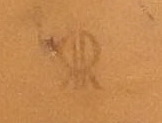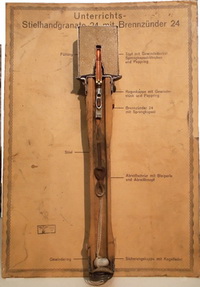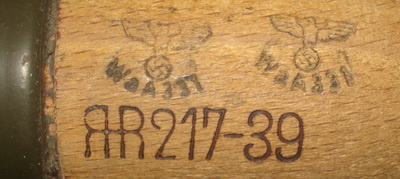

| Home | For sale | Site map | Contact information | Guest book | Stielhandgranate 24 menu |
 Stielhandgranate
24 Stielhandgranate
24  |
|---|
|
Richard Rinker, the main player According to the Treaty of Versailles of 28 June 1919 the German army was restricted both in size, as well as in number of men and weapons. Article 168 restricted the number of manufacturers that were allowed as suppliers of ordnance to the German army, and specified a list of the approved manufacturers. Each weapon type or accessory could only be made by one approved company, and some companies even made multiple weapon types. The company of Richard Rinker G.m.b.H. in Menden/Iserlohn was selected as the sole manufacturer of "Artikel 17, 18, 19 und 20. Stielhandgranaten, Eierhandgranaten, Gewehrgranaten und dazuhörige Zünder". Westfälische-Anhaltische Sprengstoff AG, Werk Reinsdorf (WASAG) was also on the list, and was the sole supplier of explosives. The company of Richard Rinker was founded in 1910 and was specialized in forged parts of brass for the building industry. One of their first products was doorknobs. Towards the 1930's most of their output was based on stampings and sheet-metal products. Their domestic items production was stopped in the prewar era, as all their capacity was needed for military production. Their company logo was a stylized double "R" with the first letter inverted, the letters joined at the middle, and with the letters in a font reminiscent of the Art Deco style of the 1920's.   The company logo to the left above. Note the big, bulging "stomach" and the very short legs. The other picture shows a ink stamp from the company found on a cardboard plate with a cut-through Stielhandgranate 24.  Click on the above picture for a full size picture of the instructional chart. Since the Stielhandgranate 24 literally was a "use and throw away" item, it is difficult to find a complete series of early versions to study. The initial marking on their products to represent "Richard Rinker G.m.b.H. in Menden/Iserlohn" was the company logo shown below. The code used by the Waffen Amt inspector at this factory was WaA65, although reading the numbers in ink can be hard sometimes.  In 1925 a coding system consisting of three numbers was introduced to hide the fact that the Germans no longer respected the conditions laid down in the Versailles treaty. Richard Rinker G.m.b.H. in Menden/Iserlohn was the only approved manufacturer so they had no need for the assigned code "336", and did not use it until 1940. In 1940 their products could be marked ЯR 1940, 1940 336 and even ЯR 1940 336 (so much for the code!).  From April 1940 a new system was introduced that was meant to replace all previously used codes, company logos or full text names of manufacturers. The system was meant to prevent allied sabotage or bombing, by hiding which companies made which items and as a result were important strategic targets. Richard Rinker G.m.b.H. in Menden/Iserlohn was issued the manufacturers code brb, but it was only used on their training grenades in 1940. This "brb 40" version stands out, as the letters are in cursive. For unknown reasons the brb code was not placed on their Stielhandgranate 24 until 1941. The "336" code was used throughout 1940 before the brb code was fully incorporated in 1941. It stayed on their handgrenades until late 1944 at the least. No 1945 dated brb marked product has been found so far, so it is possible that the code was changed in late 1944. Handles observed with the code "prd-45" appears to have been made by Richard Rinker G.m.b.H. in Menden/Iserlohn, so it is possible, but not confirmed that this was the second generation code assigned. Sometimes during the mid-30's the increased need for grenades could not be covered by the output from the factory in Menden (brb), and a second Richard Rinker factory started manufacturing the Stielhandgranate 24. This was the Richard Rinker GmbH, Neubrandenburg in Mecklenburg, which from April 1940 was issued the manufacturers code dbk. The code used by the Waffen Amt inspector at this factory was WaA560.  Although the second Richard Rinker factory used the same factory logo it is possible to tell them apart. The brb factory in Menden kept on using the Art Deco style "ЯR", while the dbk factory in Mecklenburg simply used a standard "ЯR" (small stomach and long legs) with the first letter inverted. Also easily recognizable by the WaA560, although the ink is often smeared out and unreadable, it is most of the time possible to tell if it has two or three digits.  From 1925 to 1935 all years of manufacture were to be coded as well, using a capital letter. This code can be observed on Richard Rinker made products dating from 1925 to 1935. The above handles for Übungshandgranaten (the ones most likely to survive!) were made by Richard Rinker and dated "M" for 1927 and " G" for 1935. New information added:  This picture was printed in the 1936 dated manual "Die Stielhandgranate 24 und ihre Handhabung", and show a Stielhandgranate 24 presumably tied to two duds of the same type (first version). The marking R.R.Z. denotes production by Richard Rinker in the year 1926. The complete one-letter-year-date list looks like this:
Increased needs and new makers, the "ЯR" mystery As mentioned above, the strict treaty of Versailles only allowed Germany to manufacture its military hardware in certain factories. But for the rising Reichsheer, and later Wehrmacht, the need could not be met by these factories alone. Contracts were drawn up with other manufacturers, but they had to mark their products in a way that made it look like Germany still stood by its obligations in the treaty. In 1925 a code system consisting of two or three numbers was introduced. Simson Werke in Suhl was appointed as the sole manufacturer of small arms according to the treaty, and was issued the code "S". All other manufacturers of small arms were disguised by using the same "S" code followed by the code number. As an example, Mauser-Werke AG, Oberndorf an Neckar used the code S 42. The manufacturers were not in any way under the administration of Simson, the coding was simply a way to disguise the breaches of the Versaille treaty. The same system was also used within the production of small arms cartridges and artillery cases. The sole manufacturer under the Versaille treaty was the company of Polte Armaturen- u. Maschinenfabrik AG, Magdeburg, Saxony, later renamed Polte-Werke, Magdeburg. They used the code "P", and all other manufacturers of ammunition contracted by the Heeres Waffen Amt were disguised by using the same "P" and their respective code numbers. As an example, P 131 was the code for DWM (Deutsche Waffen- u. Munitionsfabriken AG, Berlin-Borsigwalde).  Fornebu airport, Oslo 9. April 1940. German Fallschirmjägers have just landed in Norway, flown in with Ju 52 transport airplanes. Note the Stielhandgranate 24 with the white text. The same system was of course also used to disguise the manufacturers of grenades, fuses and mines. Richard Rinker, Menden was listed as the sole manufacturer. Any other company manufacturing the same type of ordnance was disguised with the code "ЯR" and a identity number of two or three digits. The tricky part was that the company of Richard Rinker didn't use normal letters on their products, they used the Art Deco logo. This lead to an array of different versions of the "ЯR" code, followed by the identity number.  A sampling of manufacturers markings on Stielhandgranate 24 cans. The first is the company logo of Richard Rinker. The second picture is the marking of "564", which was Wilhelm von Hagen Metallwarenfabrik, Iserlohn Westfalen. The "ЯR" is a not quite perfect copy of the Richard Rinker logo. The third picture is the marking of "217", Schmöle & Comp. Werk Immelborn, bei Bad Salzungen. The "ЯR" marking is a reversed "R" followed by a normal "R", but they are linked at the middle, like the original logo. The fourth picture is the marking of "90", which was Bergmann elektrizitätswerke AG, Berlin Wilhelmsruhe. The "ЯR" marking is a reversed "R" followed by a normal "R", but they are not linked at the middle, like the original logo. The last picture is the marking of "517.", which was Metallwarenfabrik Siegwerk Gebrüder Schuppener, Siegen. The "RR" marking is made up of two normal capital letters, but this company persistently used a dot after the number. So to sum it up; all manufacturers followed the standard coding system of "ЯR xxx", although there were several ways to write "ЯR". To complicate matters even more, some of the makers even changed the way of writing over the years.  Pictures courtesy of Nick Jeans The two pictures above show the marking on a can head manufactured by Hermann Wuppermann AG, Stanz- u. Emaillierwerk, Pinneberg, Hamburg. In 1939 the "ЯR" logo is a reversed "R" followed by a normal "R". Then in 1940 they change to a bigger font and a more stylized "ЯR" logo. This system was gradually replaced with the three-letter code system from April 1940 by all manufacturers, but Richard Rinker kept on using their logo well into 1941. Richard Rinker was the sole manufacturer from 1924 to the mid 1930's, and then the expanding needs resulted in more than 20 different manufacturers of the Stielhandgranate 24 in the period leading up to 1940-41. With the change from the "ЯR" coding system to the three-letter system some of the makers disappear, and some new ones enter the scene. In the timeframe 1940 to 1945 the number of manufacturers goes down to 17, and of course ends up at zero. Transitional time and confusion! Sticking to the known procedures is easy, implementing new ones can certainly be tricky.  (Picture courtesy of Truls G.) The maker behind the code aqj was S. Elster, Gassmesser- u. Gasapparatefabrik, Wien 101/XV, Felberstrasse 80. As a transitional model they dutifully replaced the code number "789" with their new code "aqj" in 1941, but kept on using the "ЯR" logo. This is the only maker I know of that made this mistake. Everyone wasn't born a team player.... There are still some mysteries surrounding the codes on the Stielhandgranate 24 that haven't been solved. The one maker that didn't use a code is easy enough, as his company logo is well known. Why he didn't use a code is entirely another story...  Picture courtesy of Tighe, USA The company logo of Fritz Weber & Co. Laternenfabrik Berlin. The only Stielhandgranate 24 maker that didn't use a code. Another mystery was the code ЯR 217. The code is all correct, but the code number is nowhere to be found in the code-list that was used from 1925 to 1940, even in the latest edition.  Picture courtesy of Moss og Rygge Krigsminnesamling This factory also changed Waffen Amt inspectors several times, so that was not a quick-fix-way to identify them. In the end it was possible to decipher it by comparing the assigned Waffen Amt inspector's number used on boxes of Druckzünder 35. The maker was Schmöle & Comp. Werk Immelborn, bei Bad Salzungen. Later production was coded dwx. .  Picture courtesy of Nick Jeans, UK One maker code that hasn't been figured out yet is the code "358-A-031". This code is clearly different from any other code encountered on German materials manufactured during the period and remains a mystery. None of the numbers match the stock number (Gerät nr). The theory so far is that "358" was the "ЯR" code number of the manufacturer. "358" was the code assigned to Vereinigte Bayerische Telephonwerke AG, but no other Stielhandgranate 24 with any other type of marking from this manufacturer has ever been observed, so there is no proof to back up this theory. Another possibility is that the code 358-A-031 isn't German at all, and that the grenades were manufactured for export to one of the allies of Germany that also fought on the Eastern front.  The different manufacturers and their individual use of the codes will be discussed more thoroughly in the section "Makers of the Stielhandgranate 24". Go back to the Stielhandgranate 24 menu |
| Home | For sale | Site map | Contact information | Guest book | Stielhandgranate 24 menu |